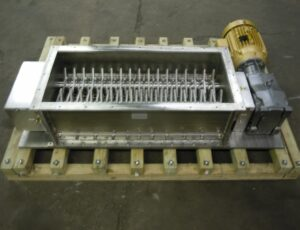
You have big, bulky materials that are gumming up the works. Or maybe you have scrap that you want to turn back into something useful. You need a machine to break things down, but which one? You’re looking at lump crushers and granulators, and you need to know which is the right fit for your operation. This guide provides an overview of both options, enabling your facility to achieve productivity gains with the right tools.
What Is a Lump Crusher?
Lump crushers are heavy hitters. Its job is to break down large, solid, caked, or agglomerated materials into smaller, flowable pieces. It uses pure impact and force. Picture hardened bags of powder, chunks of chemicals that solidified in a pipe, or filter cakes. A lump crusher applies tremendous pressure with features like a heavy-duty steel hammer or teeth on rotating shafts to smash these solid masses apart. The goal is to get the material back into a state where it can be moved, processed, or put through a screw conveyor for transport.
And What About Granulators?
A granulator is more of a precision cutting tool. While a crusher uses blunt force, a granulator uses high-speed rotating knives to slice and shear material into small, consistently sized pellets or flakes. This machine is the key product of the plastic recycling world, but it handles other materials, too.
If you have plastic scrap, runners from an injection molding process, or defective parts, a granulator is used to chop them up. The output is a uniform, reusable particle that can be fed directly back into an extrusion process.
The Upside of a Lump Crusher in Your Lineup
The main advantage of a lump crusher is its ability to handle tough, unpredictable materials. It’s built to take a beating. Placing one at the beginning of your process line protects more sensitive downstream equipment, like a fine-milling hammer mill or feeders, from damage.
This machine prevents blockages and keeps your entire line moving. It conditions bulk solids that have become a single, solid mass during storage or transport. For any food processing or chemical operation dealing with caked powder, a lump crusher is a lifesaver.
The Edge a Granulator Gives You
A granulator’s primary benefit is its ability to convert waste into revenue. All that plastic scrap that would otherwise end up in a landfill can be processed into valuable raw material. This machine gives you incredibly precise control over the final particle size, which is a big deal for quality control.
The uniform output from a granulator is perfect for reintroduction into your manufacturing processes. This creates a closed-loop system that reduces material costs and improves your facility’s environmental footprint. It’s the go-to machine for efficiently managing plastic waste.
Who Needs a Lump Crusher?
Your facility may benefit from a lump crusher if you work in industries such as chemical production, minerals and mining, pharmaceuticals, or food processing. If you find yourself with 50-pound sacks of ingredients that have turned into solid bricks, you need a crusher.
If you’re breaking down large chunks of material before they go into a finer grinding machine, a lump crusher is the right tool. It’s for anyone who deals with bulk solids that have a tendency to clump, cake, or harden over time.
When Is a Granulator the Right Call?
You’re in the granulator market if your business is centered on plastics. Injection molders, blow molders, and extrusion facilities all generate scrap that is perfect for a granulator. Recycling centers that process post-consumer plastic waste depend on this machine. If your goal is to create small, uniform granules from a relatively clean scrap source, a granulator is your answer. It’s designed for things like plastic bottles, parts, film, and other polymer-based waste.
Key Differences That Matter
While both machines reduce particle size, how they do it and what they work on are worlds apart. One is about brute force to get material moving again, and the other is about precise cutting to create a reusable product. Thinking about these core differences will point you to the right machine.
Here’s a quick breakdown:
- Action: A lump crusher uses impact and force to smash material. A granulator uses sharp knives to slice and shear material.
- Input Material: Crushers are best for hard, caked, friable solids like chemicals, sugar, or salt. Granulators excel with softer materials, especially plastic scrap.
- Output: Crushers produce smaller, irregular chunks with some powder. Granulators produce uniform, consistently sized granules or flakes.
- Primary Goal: The goal of a crusher is de-agglomeration and flow-aid. The goal of a granulator is to create reusable, high-value scrap material.
Get the Right Machine for the Job With JERSEY CRUSHER
If your operation needs a powerful, reliable machine to break down tough, caked material and keep your line running smoothly, you need a lump crusher. And not just any lump crusher. You need a JERSEY CRUSHER lump crusher. We offer a phenomenal selection of lump crushers, led by our amazing LUMPBUSTER® machinery. These units are built to handle the toughest jobs you can throw at them.
Don’t let product blockages slow you down another day. Order your LUMPBUSTER® from JERSEY CRUSHER now.
